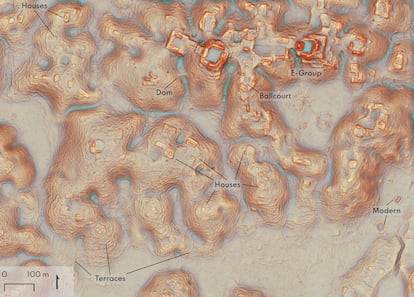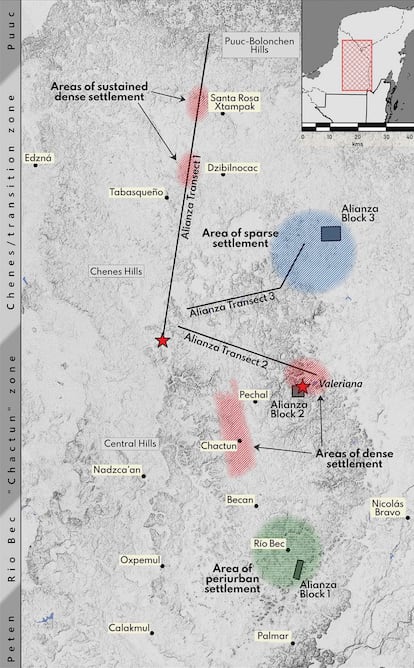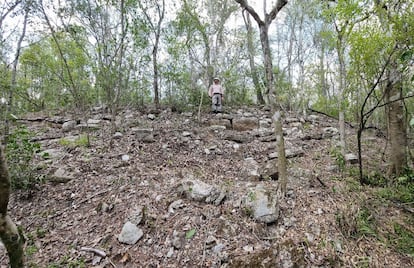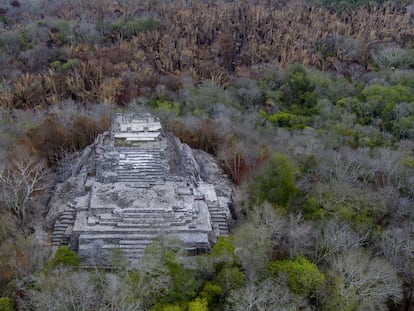Valeriana, the ancient Mayan city found thanks to laser imaging
Researchers have successfully mapped a previously unknown settlement, as well as thousands of structures that remain buried in the Mexican state of Campeche

Recent research has revealed the existence of ancient Mayan settlements buried in the Mexican state of Campeche. This discovery, based on data collected in 2013, has uncovered thousands of structures, including a city archaeologists have named Valeriana, raising new questions about the Mayan civilization. Using Light Detection and Ranging (LiDAR) technology — an advanced technique that employs laser beams to measure distances — researchers have created a detailed map of the ancient city.
The study, published in the journal Antiquity, was conducted by an international team of archaeologists from Tulane University in the United States. Using data from the 2013 project in Campeche, the researchers mapped an area of approximately 47 square miles, identifying over 6,700 pre-Hispanic structures.
An unknown Mayan city
Among the most significant discoveries is the city of Valeriana, named after a nearby lagoon. This city exhibits the typical characteristics of a political center from the Classic period (250-900 AD), featuring pyramidal temples, public squares, roads connecting various sectors, a ball court, and structures for water management. Valeriana covers approximately 7 square miles and extends along two areas of nucleation, linked by an extensive network of houses and roads.
According to the BBC, the discovery suggests that Valeriana may have been home to between 30,000 and 50,000 inhabitants at its peak. Furthermore, it is located just a 15-minute walk from a main road near Xpujil, indicating that these structures were hidden from plain sight for centuries.

A densely populated landscape
Analysis of the LiDAR data revealed a density of 55.3 structures per square kilometer (approximately 143 structures per square mile), surpassing records for comparable areas in Guatemala and Belize. The researchers identified variations in settlement density, ranging from sparsely populated rural areas to large, architecturally complex urban centers.
Evidence suggests that Maya cities in Campeche were interconnected by a network of rural settlements and agricultural zones. Terraces and walls related to agricultural activities were detected, indicating intensive land use and sophisticated infrastructure. This would have helped sustain large populations by adapting the environment for crop production and water management.
These findings provide new insights into the social and economic organization of the Mayan civilization. The high density of settlements and the presence of intricate urban and agricultural infrastructures suggest a civilization that was much more interconnected and environmentally adaptive than previously thought. The research also raises new questions and challenge long-held assumptions, such as the notion that the Maya lived in isolated villages.
The 2013 project was an initiative aimed at monitoring carbon emissions and promoting forest conservation. Initially, LiDAR data was collected to map vegetation density and its carbon sequestration potential. However, archaeologists — who would not have been able to map such a large area without prior guidance — utilized this data to investigate what they considered to be an unexplored region. Although the original goal was not to discover Mayan ruins, the team was aware of the high likelihood of finding artifacts; they were, however, unprepared for the magnitude of what they ultimately uncovered.
Understanding Campeche through archaeology
Despite the progress made, challenges remain in fully understanding the social structure and chronology of the discovered settlements. LiDAR technology cannot determine the exact age of the structures, meaning excavations and field analysis are needed to obtain accurate data. Additionally, some of the identified structures may not have served residential purposes but could have been related to other activities, which could affect population estimates.
Many sites in Campeche remain unexplored by archaeologists, and the discovery of these settlements demonstrates that new technologies can reveal secrets from the past that had previously been overlooked.

Sign up for our weekly newsletter to get more English-language news coverage from EL PAÍS USA Edition
Tu suscripción se está usando en otro dispositivo
¿Quieres añadir otro usuario a tu suscripción?
Si continúas leyendo en este dispositivo, no se podrá leer en el otro.
FlechaTu suscripción se está usando en otro dispositivo y solo puedes acceder a EL PAÍS desde un dispositivo a la vez.
Si quieres compartir tu cuenta, cambia tu suscripción a la modalidad Premium, así podrás añadir otro usuario. Cada uno accederá con su propia cuenta de email, lo que os permitirá personalizar vuestra experiencia en EL PAÍS.
¿Tienes una suscripción de empresa? Accede aquí para contratar más cuentas.
En el caso de no saber quién está usando tu cuenta, te recomendamos cambiar tu contraseña aquí.
Si decides continuar compartiendo tu cuenta, este mensaje se mostrará en tu dispositivo y en el de la otra persona que está usando tu cuenta de forma indefinida, afectando a tu experiencia de lectura. Puedes consultar aquí los términos y condiciones de la suscripción digital.
More information
Archived In
Últimas noticias
There is as much life left to discover on planet Earth as that which is already known
Dozens presumed dead, around 100 injured in fire at Swiss Alps bar during New Year’s celebration
Is porn for women different from conventional porn? We spoke to those who make it
Cartagena de Indias is sinking: What can the city do to mitigate it?
Most viewed
- Reinhard Genzel, Nobel laureate in physics: ‘One-minute videos will never give you the truth’
- David King, chemist: ‘There are scientists studying how to cool the planet; nobody should stop these experiments from happening’
- Sinaloa Cartel war is taking its toll on Los Chapitos
- Oona Chaplin: ‘I told James Cameron that I was living in a treehouse and starting a permaculture project with a friend’
- The Interoceanic Train, the Mexican alternative to the Panama Canal









































